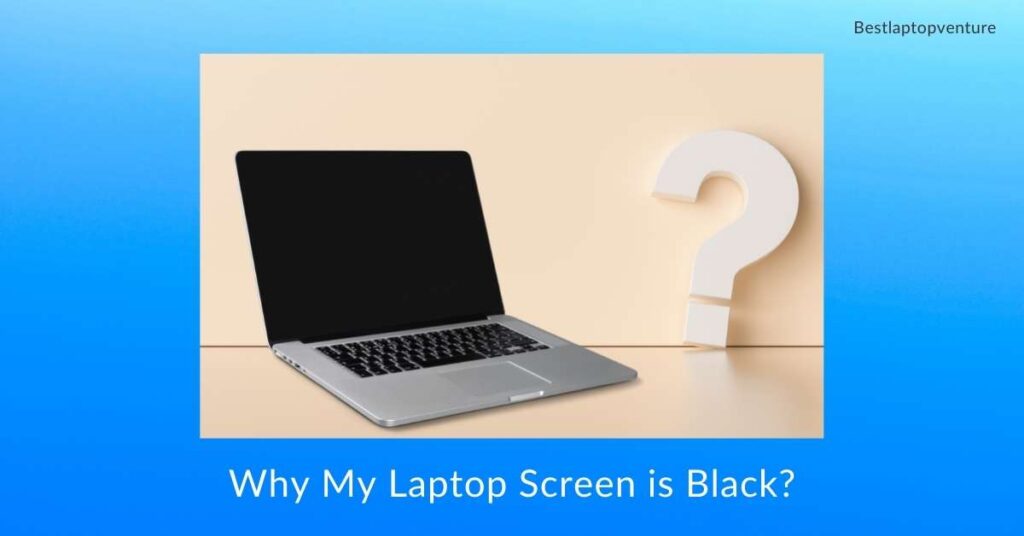
I’m hoping you’re able to determine why my laptop’s screen is black. True, laptops are critical to our lives since they enable us to work and educate ourselves.
Even if we take care of them regularly, they will eventually fail due to unintentional hardware failure.
When this occurs, our job is frequently delayed, leaving us behind.
The majority of software or hardware faults are simply recognized and then resolved since your operating system or BIOS will recognize the issue and indicate which component is at fault. Is in peril
However, there are situations when you will be unable to access the OS or BIOS at all. The laptop screen refuses to display anything and remains black throughout the laptop’s operation.
It’s just as aggravating as the other annoyances you’re dealing with; no interface will assist you in diagnosing and correcting this issue.
Numerous factors can contribute to an error in the following scenario. We wish to physically touch various laptop settings to diagnose laptop displays.
This will assist us in determining why your laptop’s screen is black, and we will be able to recommend appropriate remedies. Without further ado, here are eight possible causes for your laptop’s screen to go black:
- Check the brightness setting on your computer.
- Overheating laptop
- Remove all peri ferrules
- Troubleshooting operating system problems
- Inadequate BIOS installation
- Identifying and resolving display hardware issues
Six Reasons for a Black Screen on Your Laptop
Laptop overheating
If your laptop overheats during startup or usage and fails to show, there are numerous possible causes: –
- The laptop’s inside must be cleaned.
- Proper airflow is not permitted from the level at which the laptop is installed.
- The CPU is under load.
- There are too many graphics for a laptop’s GPU to manage.
- To begin, if you use your laptop regularly, you need to ensure that it is in good shape. Assure that you are using it in a dust-free area and that you are using a smoker intended to clean the computer one dust particle at a time.
- Placing the laptop on a hard, flat surface that does not obstruct airflow from the side vents is recommended.
This does not occur frequently, but if your CPU shuts off the laptop screen, you may want to run a search for malware or unneeded background apps that may be causing the problem.
If your PC is clean and your profession requires you to produce additional workloads, it may be time to update.
If you’re playing a game on your laptop or using software that consumes an excessive amount of GPU and the display stops working after a session, the software or games may have high system requirements.
If you wish to continue utilizing certain games or applications, it may be necessary to upgrade your laptop.
If your laptop meets the minimum system requirements or if it just stops showing sporadically.
If the CPU is not overloaded, it might be a result of the GPU shutdown. Certain laptops include both a dedicated GPU and an integrated GPU. In the BIOS, you may disable the dedicated GPU.
Troubleshooting operating system problems
Your operating system may not be the source of the problem, but it makes no attempt to determine whether there is one.
If your computer accelerates, the BIOS displays and the screen goes blank immediately after the operating system starts, there may be an issue with your VGA drivers or a file in the Windows directory.
If this is a VGA driver issue that arose later, it might be the result of a driver upgrade. You may then undo the installation.
By repeatedly plugging your PC in throughout the operating system’s bootup process, you can reach the system recovery option, which may resolve your black screen.
If it does not resolve the issue, you can attempt to install Windows Update. If the issue is OS-related, this will resolve the issue.
Check the brightness setting on your computer.
Before doing any of these diagnostic steps, ensure that the screen is not simply black due to your brightness setting. Increase your brightness setting and see if it resolves the “issue.”
Disabling All Peripherals
The majority of PC hardware problems, including visual output problems, may be resolved solely by manual removal and plug-ins.
Even if it does not resolve your issue, it might assist you in determining which component of your laptop is broken and hence causes the screen to go black.
Begin by disconnecting any external gadgets from your laptop.
While some of these, such as your mouse, gamepad, or external hard drive, may not be the source of the problem, detaching them will assure that you get to the source.
VGA, DVI, HDMI, or Thunderbolt connections can be used to connect devices that cause your screen to go black. Restart your computer after disconnecting all of these devices.
If the issue is resolved, it is quite probable that one or more of these components was the source of the issue.
Contact them one by one until you determine which gadget is causing the issue. Later, if it becomes damaged, you can repair or replace it.
How to Perform a Hard Reset on a Laptop
The issue is unknown at the moment. Resetting a laptop is unlikely to help. Follow these procedures to troubleshoot a laptop:
Disconnect all power sources and take out the battery. All external devices and peripherals should be disconnected.
For many seconds, press and hold the power button. After a few moments, reconnect the power source and disconnect the battery.
When the starting option displays, turn on the laptop and choose “Start Windows normally.”
Display for issue detection
If the laptop screen does not provide an output signal, another issue may exist, but the LCD may be destroyed.
Connect your laptop to another LCD display through an HDMI, DVI, or VGA connector to verify this (depending on port and cable availability).
Any output from a connected monitor indicates that the LCD has a poor inverter, a bad backlight, or the LCD is damaged.
If the laptop is still covered by the manufacturer’s warranty, you can contact the manufacturer. Otherwise, the laptop will require repair at a service center.
FAQs on Why My Laptop Screen is Black?
What should I do if the computer is turned on but the screen is black?
If the problem persists, restart your computer. Ascertain that the monitor is selected. While the majority of systems self-identify, it never hurts to verify. To be on the safe side, increase the brightness.
What could be the reason for my laptop screen being black?
There could be several reasons why your laptop screen is black. Some common reasons include a loose or faulty connection between the display and the computer, a damaged or faulty display, or a problem with the computer’s graphics card or video driver.
What should I do if my laptop screen is black?
If your laptop screen is black, the first thing you should do is check the connections between the display and the computer. Make sure that the cables are securely connected and that there are no loose or damaged connections.
If the connections are fine, try restarting your computer to see if that fixes the problem. If the problem persists, try updating your graphics card driver or checking for any updates to your operating system.
Can a black screen be caused by a software issue?
Yes, a black screen can sometimes be caused by a software issue, such as a problem with the operating system or a problem with a specific program or application.
If you suspect that a software issue is causing your laptop screen to be black, try restarting your computer and running a diagnostic test to check for any problems with the software.
Is it possible to fix a black screen on my own?
In some cases, it may be possible to fix a black screen on your own by troubleshooting the problem and making the necessary repairs or adjustments.
However, if you are not experienced with fixing computer hardware or software issues, it is best to consult a professional for assistance.
What should I do if I can’t fix the black screen on my own?
If you are unable to fix the black screen on your own, it is best to consult a professional for assistance. A qualified technician will be able to diagnose the problem and make the necessary repairs to get your laptop working properly again.
It is important to avoid attempting to repair the problem yourself if you are not experienced with fixing computer hardware or software issues, as this could potentially cause further damage to your computer.
Conclusion on Why My Laptop Screen is Black
Needless to say, whether you use your laptop for personal or business purposes, you should constantly take care of it.
Always place your laptop on a firm, level surface and avoid obstructing the ventilation points. If your laptop continues to overheat during use, consider purchasing a laptop cooler.
When turning it off, take care to carefully close the lid. Avoid running apps that demand a system definition that is significantly higher than the one on your laptop.
Before changing your BIOS, see your laptop’s instructions. Bear in mind that a little tenderness may go a long way!
Read also: Why Isn’t My iMessage Working On My Laptop

![9 Best Laptops For CATIA in July 2025 [Expert Recommended] 3 Best Laptops for CATIA](https://bestlaptopsventure.com/wp-content/uploads/2024/03/best-laptops-for-catia.jpg)
![9 Best Laptops with MX150 Graphics in July 2025 [Expert Recommended] 4 Best Laptops with MX150 Graphics](https://bestlaptopsventure.com/wp-content/uploads/2024/02/best-laptops-with-mx150-2.jpg)
![9 Best Laptops For College Students Under 500 Dollar in July 2025 [Expert Recommended] 5 Best Laptops For College Students Under 500 Dollar](https://bestlaptopsventure.com/wp-content/uploads/2024/02/best-laptops-college-students-500-dollar.jpg)
![Are Decals or Stickers on a Laptop Unprofessional? [Ultimate Guide] 6 A girl with a laptop which has many stickers.](https://bestlaptopsventure.com/wp-content/uploads/2024/03/are-decals-or-stickers-on-a-laptop-unprofessional-1024x536-1.jpg)
![9 Best Laptops For Embroidery Software in July 2025 [Expert Recommended] 7 Best Laptop For Embroidery Software](https://bestlaptopsventure.com/wp-content/uploads/2024/03/best-laptop-for-embroidery-software.jpg)
![How to Increase FPS on Laptop in Windows 10/11 [Step-by-Step] 8 How to Increase FPS on Laptop](https://bestlaptopsventure.com/wp-content/uploads/2024/02/how-to-increase-fps-on-laptop.jpg)

![9 Best Laptop For Silhouette Portrait in July 2025 [Expert Recommended] 10 Best Laptop for Silhouette Portrait](https://bestlaptopsventure.com/wp-content/uploads/2024/02/Best-Laptops-for-Silhouette-Portrait.jpg)
![9 Best DELL Laptops with Backlit Keyboard in July 2025 [Expert Recommended] 11 Best DELL Laptops with Backlit Keyboard](https://bestlaptopsventure.com/wp-content/uploads/2024/03/Best-dell-laptops-with-backlit-keyboard-1024x536-1.jpg)
![How to Factory Reset MSI Laptop? [Guide by MSI Geeks] 12 How to Factory Reset MSI Laptop](https://bestlaptopsventure.com/wp-content/uploads/2024/03/how-to-factory-reset-msi-laptop-1024x536-1.jpg)